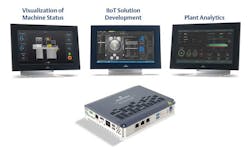At a Glance:
- OEMs need to consider not just the power of an industrial PC, but also the environment in which it will operate.
- Scalability and flexibility are important as new software is needed or new systems are added.
- Industrial PCs can do processing work outside of the network, which helps deliver better information to the end-user.
Finding the right balance between too few choices and too many can be a thorny problem even in the simplest situations. For more complicated endeavors like Industrial Internet of Things (IIoT) implementations, end-users appreciate some decision-making latitude, but most want proven combinations of hardware and software solutions.
Manufacturing companies and original equipment manufacturers (OEMs) everywhere need their existing and new machines and systems to deliver IIoT benefits, but there are so many data sources and technologies involved that they can quickly lose their way on their digital transformation journey.
Implementations require tapping into and processing all types of industrial data, not just from automated machines, but also from smart instruments and monitoring systems. A flexible and capable platform for doing so is built on industrial PCs (IPCs) running the right software, but end-users must zero in on just the right combination.
Corralling the Chaos
Industrial end-users are already convinced of the need for IIoT data to support their efforts in optimizing operations, gaining system insights and performing proactive maintenance. However, operational assets come in all sizes, types and vintages. Any IIoT solution must therefore be flexible and adaptable enough to access all sorts of data sources.
Most of the data sources are located at the relatively inhospitable industrial edge, where extreme heat, cold, shock and vibration can combine to destroy any type of digital device. Typical consumer- or commercial-grade information technology (IT) assets like PCs don’t work for long in these environments, and these sites usually have limited IT personnel support. The typical IT device lifetime is about three years, which is not a good match for operational technology (OT) systems which must run far longer—sometimes decades.
Industrialized PCs are widely available, but the reality is some users are finding in practice that many IPCs simply don’t deliver the promised performance, reliability or longevity. Part of the blame here lies with testing regimens that may be overly optimistic, or at least not sufficiently aggressive. Another aspect is that many industrial users need hardware scalability options which simply aren’t available on typical PCs, or even IPCs.
IIoT installations also require many types of OT-centric software. While this software is available as a separate purchase, there are downsides to selecting so many products, matching them to the right hardware configurations and managing multiple vendors. The ability to combine IPC hardware and software purchases from one vendor simplifies the ordering process, reduces installation and application development effort and required maintenance, and provides a single point of accountability.
Built for OT
World-class IPCs are created with detailed attention to design, testing and OT industry needs. A chief concern is designing the IPCs to be fanless, with careful heat sink arrangements to avoid hot spots and promote optimal thermal conductive paths to the external environment. This includes not only primary components like CPUs, but also often-neglected secondary components like SSDs.
Other subtle design and testing considerations come into play. A quality IPC should also be designed using a zero-throttle principle, which means the thermal rating is designated at a 100% performance rating. Some IPCs claim an extended temperature operating range but may throttle the CPU to do so. IPCs should be tested in zero airflow conditions to mimic real-world cabinet installations, but some IPCs may be tested to less rigorous standards, often with simulated air flow.
Companies with deep OT experience know how to design products and solutions meeting unique OT needs far better than IT companies. OT-centric IPCs are built and supported for an extended lifecycle/lifespan and will continue to be supported for five years, even after product maturity. IPC upgrades and refreshes are designed for compatibility with older models to the greatest extent possible, especially with respect to form factors and interfaces. Most OT users are better served by selecting from a few alternatives of known-good configurations to simplify ordering and stocking, and this concept extends to software procurement.
Loaded for Big Game
IPCs are suitable for a wide variety of applications, but there are many typical roles and associated software suites for IIoT applications that could be hosted or bundled on IPCs to increase the value to end-users, such as:
IIoT. A curated group of open-source software tools to provide a secure and controlled environment which won’t require IT expertise for implementation. These tools empower OT users to collect data using various protocols, and to develop algorithms so they can identify machine health and generate insights for improving their operations.
Visualization. Recent developments in this area involve the use of templates, wizards and other features so users can develop intuitive and interactive displays which can be viewed locally, or as web views using any device capable of hosting a web browser.
Gateway. Equipped with the right data server software and protocols such as OPC UA, MQTT and other protocols needed for connecting to data sources, an IPC can work as a connectivity engine for data acquisition, server and logger tasks. This role is essential for supporting higher-level SCADA, MES and ERP applications, or for establishing cloud connectivity.
Analytics. While an IPC can essentially be programmed to do anything, there are OT-specific analytical software packages with standards features and wizards for acquiring real-time production data and determining key performance indicators (KPIs), overall equipment effectiveness, calculating machine downtime, tracking production, scheduling and more.
Remote monitoring. Many of the preceding software roles include a remote monitoring aspect. IPCs can run web client technology to provide secure remote access to the applications using browser-based HTML5 technology on any remote device, or native mobile applications. These remote views can include visualization, web reports and analytical dashboards.
There are many types of end-users. Some may choose to buy “bare metal” IPCs without even an operating system installed so they can build up their configurations with the exact required mix of commercial and/or proprietary software. But even some sophisticated end-users may prefer a more streamlined approach where the IPC arrives pre-loaded with the operating system and perhaps other applications, an option offered by some OT-focused IPC experts.
OEM Edge
Built for industrial installations but featuring PC capabilities, IPCs can collect little data from all types of disparate sources in the most challenging edge locations. The computing power of IPCs enables them to create big data by pre-processing. This also serves to minimize the data payload of IIoT implementations, improving the efficiency of storing/forwarding information, which is required for low bandwidth connections.
Industrial end-users and OEMs can find efficiencies by standardizing on an OT-based provider of IPC solutions. An IPC running the right software suites is equally at home when used for building IIoT capabilities into new systems of all types, or for retrofits. However, the IPC must be ruggedly built with the performance, durability and longevity required for OT service.
Silvia Gonzalez is a solutions development leader for Emerson's Machine Automation Solutions business. She is responsible for creating, developing and driving solutions-oriented approaches for translating end-user challenges into improved operational performance.
Nishita Palkar is senior product manager of the industrial PC portfolio for Emerson's Machine Automation Solutions business. In this role, she leads the global product portfolio and product strategy for Emerson's Industrial PCs.

